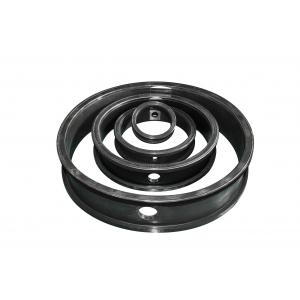

Add to Cart
Black EPDM Valve Seat with low torque for centerline butterfly valve
Basic characteristics of EPDM:
1. The relative density of EPDM rubber is small (0.85-0.86), and it
still has the characteristics of ozone resistance, weather
resistance, heat resistance and chemical stability of binary
ethylene propylene rubber.
2. It can be vulcanized by sulfur vulcanization system or
crosslinked with organic peroxide to produce high strength
products.
3. Good low temperature resistance and electrical insulation
performance.
4. It can withstand the high capacity of fillers and oils when
blended.
5. Compatible with unsaturated rubber, low-unsaturated rubber and
plastic.
6. Due to the good physical properties of the vulcanized rubber
surface, it is suitable for making foamed products.
7. Unvulcanized rubber has poor adhesion.
Applications: Mainly used in the automotive industry, wire and
cable industry, construction and waterproof materials, industrial
rubber products, civil products, combined with other rubber and
plastic resins, or blended, and additives.
Our Technical Capacity:
Project Engineering Group and Technical Group.
R&D Capabilities: Our experts group can provide all-round supports to products and mold design, material formula and process optimization.
Independent Physics Laboratory and High-Standard Quality Inspection.
Implement project management system to ensure smooth transfer and constant improvements from project lead-in to mass production.
Related Material Quick Selection Table:
| Material | Suitable Temp. | Characteristics |
| NBR | -35℃~100℃ Instant -40℃~125℃ | Nitrile rubber has good self-expanding properties, abrasion resistance and hydrocarbon-resistant properties. It can be used as a general material for water, vacuum, acid, salt, alkali, grease, oil, butter, hydraulic oil, glycol, etc. Can not be used in places such as acetone, ketone, nitrate, and fluorinated hydrocarbons. |
| EPDM | -40℃~135℃ Instant -50℃~150℃ | Ethylene-propylene rubber is a good general-purpose synthetic rubber that can be used in hot water systems, beverages, dairy products, ketones, alcohols, nitrates, and glycerin, but not in hydrocarbon-based oils, inorganics, or solvents. |
| CR | -35℃~100℃ Instant -40℃~125℃ | Neoprene is used in media such as acids, oils, fats, butters and solvents and has good resistance to attack. |
| FKM | -20℃~180℃ | Fluororubber is a good hydrocarbon-resistant base oil, fluorinated hydrocarbon rubber for oily gas and other petroleum products. It is suitable for water, oil, air, acid and other media, but it can not be used for steam, hot water or thicker than 82 °C. Alkali system. |
| SR | -70℃~200℃ | Silicone rubber is resistant to high temperature, low temperature and stable chemical properties, and is widely used in industries such as strong acid, weak alkali and food. |
Special materials: carboxylated nitrile rubber, hydrogenated nitrile rubber, corrosion-resistant ethylene-propylene rubber, steam-resistant fluoroelastomer, chlorosulfonated polyethylene | ||
